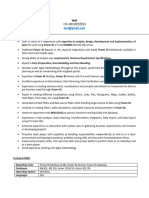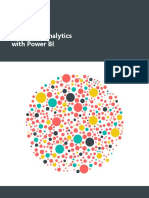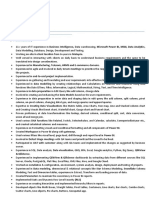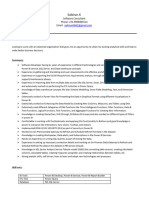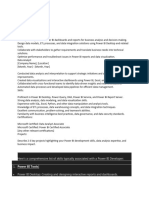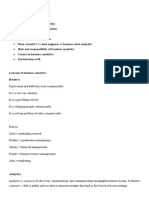Title: Data Analysis Using Postgresql and Power Bi
Title: Data Analysis Using Postgresql and Power Bi
Uploaded by
imamshauzab11Copyright:
Available Formats
Title: Data Analysis Using Postgresql and Power Bi
Title: Data Analysis Using Postgresql and Power Bi
Uploaded by
imamshauzab11Original Title
Copyright
Available Formats
Share this document
Did you find this document useful?
Is this content inappropriate?
Copyright:
Available Formats
Title: Data Analysis Using Postgresql and Power Bi
Title: Data Analysis Using Postgresql and Power Bi
Uploaded by
imamshauzab11Copyright:
Available Formats
Title: Data Analysis Using PostgreSQL and Power BI
Mayank Thakur1, Maneesh Sharma1, Faizan1, Muthuperumal2
1- Final Year Undergraduate (B-Tech Computer Science), BIST, BIHER, Chennai.
2- Associate Professor, Department of Computer Science, BIST, BIHER, Chennai
Abstract
This research paper explores the integration of two powerful tools, PostgreSQL and Power
BI, to provide comprehensive data analysis. PostgreSQL, an open-source relational database
management system, offers robust data management capabilities, including complex queries,
indexing, and transaction management. Its scalability and extensibility make it suitable for
diverse applications, with added versatility through geospatial capabilities and support for
semi-structured data. On the other hand, Power BI, a Microsoft business analytics service,
enables users to connect to various data sources, transform and model data, and create
interactive reports and dashboards. Its key components include Power BI Desktop for report
creation, Power BI Service for sharing and collaboration, and Power BI Mobile for access
on mobile devices. Furthermore, features such as data connectivity, DAX, and custom visuals
enhance its capabilities. The synergy between PostgreSQL and Power BI allows
organizations to extract and transform data from PostgreSQL using Power Query, model
data relationships and create visualizations in Power BI, perform advanced analytics,
automate data refreshes for up-to-date insights, and collaborate and share reports
seamlessly. In conclusion, integrating these two tools empowers organizations to explore,
analyse, and communicate data comprehensively, driving better business outcomes
1. Introduction service developed by Microsoft, enables
users to connect to data sources, transform
Data analysis is crucial in shaping and model data, and create interactive
organizational strategies, driving informed reports and dashboards. The combination
decision-making, and driving competitive of PostgreSQL and Power BI empowers
success. It involves collecting vast organizations to effectively analyze data,
amounts of data from various sources, enhancing decision-making processes,
such as customer interactions, sales, and driving business growth, and optimizing
operations, and transforming it into overall operations.
actionable insights. This allows leaders to
make informed decisions, optimize 2. Integrate PostgreSQL with Power BI
marketing campaigns, allocate resources,
and launch new products. Companies that PostgreSQL and Power BI are popular data
harness data gain a competitive advantage management solutions due to their robust
by understanding market trends, customer capabilities, adherence to ACID properties,
behavior, and competitor performance. and ability to handle geospatial data.
Data analysis leads to operational PostgreSQL supports complex queries,
efficiency, productivity, personalization, indexing, and transaction management,
predictive analytics, risk management, making it suitable for large datasets. Its
strategic planning, and forecasting. architecture allows for horizontal and
PostgreSQL, also known as Postgres, is an vertical scaling, and developers can
open-source relational database customize solutions for specific business
management system (RDBMS) with needs. Power BI offers a variety of data
advanced capabilities, scalability, and visualization capabilities, including
extensibility. Power BI, a business interactive dashboards, reports, cross-
analytics
filtering, slicers, conditional formatting,
and Q&A features. Power BI reports are 3.2 Flow Chart
mobile responsive, can be integrated with
other Microsoft tools, and can be
embedded in web pages or applications for
easy access and sharing. Overall,
PostgreSQL and Power BI provide a
comprehensive and versatile solution for
data management and analysis.
Power BI is a powerful data analysis tool
that allows users to automate data
refreshes, ensuring the latest information is
always reflected in their reports and
dashboards. It connects to various data
sources, detects changes in source data,
and handles scheduled refreshes without
manual intervention. The Power BI
Gateway facilitates scheduled refreshes
without manual intervention, and users can
configure single sign-on for seamless
authentication. The incremental refresh
feature reduces refresh time and optimizes
performance for large datasets. The cloud-
based Power BI Service handles scheduled
refreshes and real-time data scenarios.
When combined, PostgreSQL and Power
BI create a comprehensive data analysis
solution, allowing users to efficiently store
and manage structured data, perform
advanced analytics, and support geospatial
and temporal analysis. Both platforms
offer custom visualizations and third-party
extensions for specific reporting needs.
3.1 Algorithm
1. Prepare Data in PostgreSQL
2. Write SQL Queries
3. Clean & Transform Data (Optional)
4. Export Data (Optional)
5. Connect to Power BI 4. Understanding Power BI and
6. Import Data PostgreSQL
7. Data Transformation in Power
BI (Optional) Microsoft's Power BI is a business
8. Create Reports & Visualizations analytics service that enables users to
9. Gain Insights & Share Results connect to data sources, transform and
model data, and create interactive reports
and dashboards. It consists of three
components: Power BI Desktop, Power
BI Service (Cloud), and
Power BI Mobile. Power BI offers data including area charts, bar and column
connectivity, data transformation through charts, cards, combo charts, decomposition
Power Query, data modeling, and trees, doughnut charts, and funnel charts.
visualizations. It uses DAX for custom To create meaningful reports using
calculations. PostgreSQL is an open- PostgreSQL data in Power BI, connect to
source relational database management the database, load relevant tables, and use
system (RDBMS) with robust data Power Query to clean, shape, and
management capabilities, scalability, transform data.
extensibility, ACID compliance, and
geospatial capabilities. It is used in web Create visualizations by dragging and
applications, analytics, scientific research, dropping fields onto the report canvas and
and geospatial data. Power BI is used for choosing from various types such as bar
data exploration, while PostgreSQL is used charts, line charts, pie charts, tables, maps,
for data storage, management, and cards, combo charts, and the
transformation. To integrate PostgreSQL decomposition tree. Customize visuals by
with Power BI, follow these formatting colors, fonts, and axes, adding
steps: titles, labels, tooltips, and conditional
formatting for emphasis. Arrange visuals
1. Install NpgSQL 4.0.10 with Power BI on report pages, add slicers for interactive
Desktop. filtering, and create bookmarks for
2. Install the NpgSQL provider on your different views.
local machine.
3. Connect to PostgreSQL from Power Build interactive dashboards using
Query Desktop. PostgreSQL data in Power BI requires
4. Open Power BI Desktop and choose Get careful consideration of user needs and
Data > Database > PostgreSQL. effective dashboard design. Understand the
5. Enter your credentials in the target audience's roles, responsibilities, and
PostgreSQL database dialog. decision-making requirements to tailor the
dashboard to their unique needs. Connect
To connect Power BI to a PostgreSQL to PostgreSQL data in Power BI, import
database, launch the Power BI Desktop relevant tables, and define relationships.
and click "Get Data" from the Home tab. Power Query can be used to transform and
In the "Get Data" window, search for the clean the data.
PostgreSQL database and click "Connect".
Configure the connection by providing the Integrate visualizations and interactivity
server name, database name, and with drill-through actions, slicers for
authentication credentials. Test the interactive filtering, and bookmarks for
connection and click "OK" to establish it. different views. Test and iterate to ensure
Select tables and data from the functionality and meet user feedback.
PostgreSQL database and load the data Consistent layout and branding, effective
into your Power BI model. Use Power data storytelling, accessibility and
Query to transform and shape the data, responsiveness, and performance
define relationships between tables, and optimization are essential elements for
create visualizations to represent insights. creating a successful interactive dashboard.
Save and publish your Power BI file,
publish it to the Power BI Service (cloud), PostgreSQL integration in Power BI
or share it with colleagues. requires advanced data modeling
techniques, such as DAX (Data Analysis
5. Visualizations and Report Expressions), which enable intricate
computations, time intelligence, and
Power BI offers a variety of visualization aggregations. DAX functions like
options to effectively present data,
{SUMX}, {AVERAGE}, {COUNT}, and
`FILTER} can be used for calculations, Performance bottlenecks can impact the
custom calculations, and complex responsiveness of your dashboard, so
aggregations. Understanding data optimize your PostgreSQL. Future
relationships is crucial for efficient data developments and updates for Power BI's
modeling. Performance optimization PostgreSQL integration include calculated
strategies like data refresh schedule tables, improved collaboration and sharing,
optimization and huge table splitting can performance optimization, expansion of
improve overall efficiency. data connectors, enhanced visualizations,
and seamless integration with Azure
To optimize performance, eliminate services.
unnecessary tables and columns, establish
correct relationships between tables, and In summary, troubleshooting common
understand the differences between one-to- issues with PostgreSQL and Power BI
many and many-to-one relationships. Use integration is crucial for ensuring smooth
calculated columns and measures sparingly, and efficient data management.
opt for measures, and use filters effectively
to limit data processing. Divide large
tables into smaller sections for better query Conclusion:
performance. Implement indexes on
columns for improved data retrieval speed. To sum up, PostgreSQL integration with
Understanding DAX syntax, functions, and Power BI is an effective mix for effective
context is essential. DAX can be used for
data analysis. Strong data management
complex calculations and measures, but
features offered by this integration make it
optimizing queries using query folding and
considering performance implications is possible to store, query, and manage
also crucial. structured data effectively. This capacity is
further enhanced by Power BI's data
6. Common Issues with PostgreSQL and modeling features, which let users define
Power BI Integration relationships, calculated columns, and
metrics for insightful data. Furthermore, a
Common issues with PostgreSQL and variety of Power BI visualizations,
Power BI integration include including tables, charts, and maps, allow
authentication problems, connectivity for efficient data display. Data-driven
issues, data import errors, and performance decisions can be made by seeing trends,
bottlenecks. To resolve these, double- patterns, and anomalies using a connection
check your credentials and ensure the
to PostgreSQL. Furthermore, sharing
PostgreSQL server allows connections
from your Power BI instance's IP address. reports, dashboards, and insights inside
Whitelist the IP address in the PostgreSQL businesses is made simple by Power BI's
server's firewall settings and test the collaboration and sharing tools. The
connection using a PostgreSQL client correct data is delivered at the appropriate
tool like pgAdmin. moment to the appropriate stakeholders
thanks to the interaction with PostgreSQL.
Data import errors can occur due to
incorrect table or column names, data type 9 References
mismatches, or missing data. Verify that 1. Kimball, R., & Ross, M. (2013). The Data
the table and column names in Power BI Warehouse Toolkit: The Definitive Guide to
match those in your PostgreSQL database, Dimensional Modeling. John Wiley & Sons.
check data types for consistency, and
inspect the data for missing or
invalid values.
2. Inmon, W. H., & Hackathorn, R. D. (2001). Journal of Operational Research, 138(1), 191-
Using the Data Warehouse. John Wiley & 211.
Sons.
17. Guo, Y., & Sheng, Q. Z. (2009). A
3. Dixon, M. (2009). Sales Analysis Bayesian Network Approach to Improving
Techniques: A Guide for Sales Managers. Sales Forecasts Accuracy in E-commerce.
Kogan Page Publishers. Decision Support Systems, 48(4), 603-612.
4. Microsoft. (n.d.). Power BI Documentation. 18. Liu, Y., Gruenwald, L., & Sopan, A.
Retrieved from https://docs.microsoft.com/en- (2008). Data Mining in Sales Forecasting: A
us/power-bi/ Review. European Journal of Operational
5. Ferrari, A., & Russo, M. (2016). Analyzing Research, 180(2), 690-705.
Data with Power BI and Power Pivot for 19. McFadden, D. (1974). Conditional Logit
Excel. Microsoft Press. Analysis of Qualitative Choice Behavior. In P.
6. Redmond, E., & Wilson, J. (2016). Zarembka (Ed.), Frontiers in Econometrics
Microsoft Power BI Cookbook: Creating (pp. 105-142). Academic Press.
Business Intelligence Solutions of Analyzing 20. Hennig-Thurau, T., & Hansen, U. (2000).
Data to Sharing Insights. Packt Publishing Ltd. Relationship Marketing: Gaining Competitive
7. Naylor, J. (2006). SQL for Dummies. John Advantage Through Customer Satisfaction and
Wiley & Sons. Customer Retention. Springer.
8. Ramakrishnan, R., & Gehrke, J. (2002).
Database Management Systems. McGraw-Hill
Education.
9. Stonebraker, M., & Hellerstein, J. M.
(2005). Readings in Database Systems. MIT
Press.
10. PostgreSQL Documentation. (n.d.).
Retrieved from
https://www.postgresql.org/docs/
11. Kline, D. (2012). PostgreSQL 9.0 High
Performance. Packt Publishing Ltd.
12. Silberschatz, A., Korth, H. F., & Sudarshan,
S. (2019). Database System Concepts.
McGraw-Hill Education.
13. De Haan, R., & Kuijpers, S. (2016).
PostgreSQL 9 Administration Cookbook.
Packt Publishing Ltd.
14. Kim, J. Y. (2008). Data Mining for the
Masses. Trafford Publishing.
15. Han, J., Kamber, M., & Pei, J. (2011).
Data Mining: Concepts and Techniques.
Morgan Kaufmann.
16. Baesens, B., Viaene, S., Van den Poel, D.,
Dedene, G., & Vanthienen, J. (2002). Bayesian
Neural Network Learning for Repeat Purchase
Modelling in Direct Marketing. European
You might also like
- Clemson Olympic Sports Science Playbook (Fall 2024)No ratings yetClemson Olympic Sports Science Playbook (Fall 2024)16 pages
- Chenchu Soma Sundar 9989718910: E-Mail Id Mobile No100% (2)Chenchu Soma Sundar 9989718910: E-Mail Id Mobile No3 pages
- EDx Data Science For Construction, Architecture and Engineering Launch 3 Syllabus0% (1)EDx Data Science For Construction, Architecture and Engineering Launch 3 Syllabus9 pages
- Python in Power BI - Unleash The - Hayden Van Der Post100% (3)Python in Power BI - Unleash The - Hayden Van Der Post475 pages
- Ramanjneyulu Gorige - BI Support DeveloperNo ratings yetRamanjneyulu Gorige - BI Support Developer5 pages
- PowerBI Developer - Business Analyst Resume - Hire IT People - We Get IT DoneNo ratings yetPowerBI Developer - Business Analyst Resume - Hire IT People - We Get IT Done5 pages
- Introduction To Power BI: by Koushik VodapalliNo ratings yetIntroduction To Power BI: by Koushik Vodapalli10 pages
- Powerbiinterviewquestionspdfbyscholarhat 240716104017 E79d91b9No ratings yetPowerbiinterviewquestionspdfbyscholarhat 240716104017 E79d91b918 pages
- What are the Products Available in the Market for Power BINo ratings yetWhat are the Products Available in the Market for Power BI5 pages
- Power BI Essentials_ A Step-by-Step Training GuideNo ratings yetPower BI Essentials_ A Step-by-Step Training Guide4 pages
- Sample 0811 Advanced Analytics With Power Bi100% (1)Sample 0811 Advanced Analytics With Power Bi7 pages
- Unlocking the Potential of Big Data with Power BI for Real-Time Analysis and VisualizationsFrom EverandUnlocking the Potential of Big Data with Power BI for Real-Time Analysis and VisualizationsNo ratings yet
- Network Traffic Analyzer Project Proposal OS LabNo ratings yetNetwork Traffic Analyzer Project Proposal OS Lab6 pages
- Practical Guide To Matplotlib For Data Science100% (1)Practical Guide To Matplotlib For Data Science35 pages
- Data Visualization For Python - Sales Retail - r1No ratings yetData Visualization For Python - Sales Retail - r119 pages
- Upgrad Campus - Business Analytics BrochureNo ratings yetUpgrad Campus - Business Analytics Brochure11 pages
- Cbse Class 12 Informatics Practices Term1 Solved Question Paper 2022No ratings yetCbse Class 12 Informatics Practices Term1 Solved Question Paper 202225 pages
- Clemson Olympic Sports Science Playbook (Fall 2024)Clemson Olympic Sports Science Playbook (Fall 2024)
- Chenchu Soma Sundar 9989718910: E-Mail Id Mobile NoChenchu Soma Sundar 9989718910: E-Mail Id Mobile No
- EDx Data Science For Construction, Architecture and Engineering Launch 3 SyllabusEDx Data Science For Construction, Architecture and Engineering Launch 3 Syllabus
- Python in Power BI - Unleash The - Hayden Van Der PostPython in Power BI - Unleash The - Hayden Van Der Post
- PowerBI Developer - Business Analyst Resume - Hire IT People - We Get IT DonePowerBI Developer - Business Analyst Resume - Hire IT People - We Get IT Done
- Powerbiinterviewquestionspdfbyscholarhat 240716104017 E79d91b9Powerbiinterviewquestionspdfbyscholarhat 240716104017 E79d91b9
- What are the Products Available in the Market for Power BIWhat are the Products Available in the Market for Power BI
- Power BI Essentials_ A Step-by-Step Training GuidePower BI Essentials_ A Step-by-Step Training Guide
- Unlocking the Potential of Big Data with Power BI for Real-Time Analysis and VisualizationsFrom EverandUnlocking the Potential of Big Data with Power BI for Real-Time Analysis and Visualizations
- Cbse Class 12 Informatics Practices Term1 Solved Question Paper 2022Cbse Class 12 Informatics Practices Term1 Solved Question Paper 2022



























